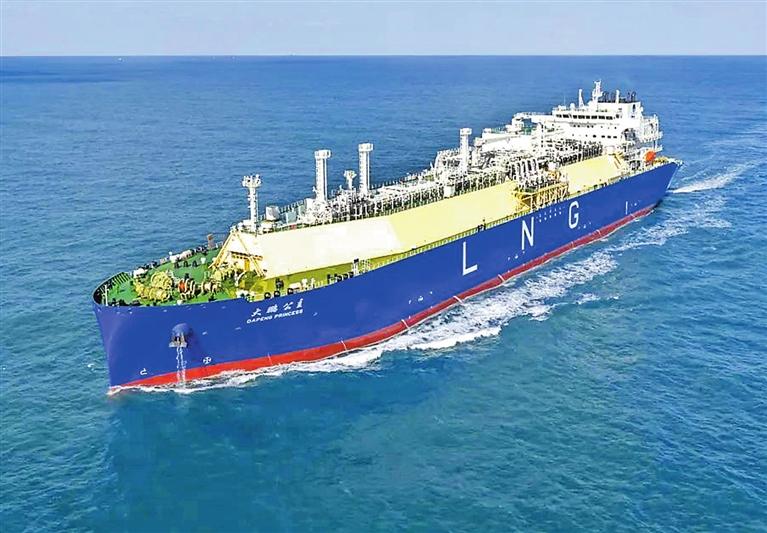
The "Dapeng Princess" liquefied natural gas carrier sails, which was supported by China Export & Credit Insurance Corp. Shenzhen Branch, sails. The vessel is the world's largest fourth-generation liquefied natural gas carrier for shallow water and epitomizes Shenzhen's commitment to expanding cooperation with BRI partner countries. Shenzhen Economic Daily
Shenzhen, which is well known as a massive manufacturing center with assembly lines churning out computers, phones, and other high-tech gadgets, is also one of China's three financial hubs with a highly developed financial sector.
According to the Global Financial Centers Index, jointly published by think tanks China Development Institute and London-based Z/Yen in 2022, Shenzhen was 10th in the global rankings of financial centers, moving up six places from half a year earlier and trailing Shanghai at fourth and Beijing at eighth.
Shenzhen is home to a host of financial heavyweights such as Ping An Insurance Group, China Merchants Bank, Shenzhen Capital Group, and CITIC Securities Co. and also hosts one of the country's stock markets — the Shenzhen Stock Exchange. Shenzhen is also among the country's first batch of cities to trial-run the use of the digital yuan, which is expected to increase the efficiency of financial operations and lower the costs of financial transactions.
Finance has long been one of the pillar industries in Shenzhen's economic growth and has played an important role in facilitating the city's foreign trade and overseas investment, as demonstrated in Shenzhen's multilateral financial cooperation with Belt and Road Initiative (BRI) countries in recent years.
Financial cooperation
Over the past years, Shenzhen has actively carried out financial cooperation with BRI countries and built a multi-level financial services system to provide diversified financial support for the growth of both local and partner countries' economies.
As part of the financial cooperation under the BRI, Shenzhen won approval from China's central bank to set up a yuan-based overseas investment and financing fund in 2019. The yuan fund is the only one in the Guangdong-Hong Kong-Macao Greater Bay Area and one of only three in the country that are still actively operating.
In 2020, the fund was granted an initial outbound investment quota of 10.50 billion yuan (US$1.46 billion) by China's top economic planner and was allowed to conduct investment operations in Hong Kong.
Meanwhile, business delegations, both official and private, sped up their push to seek overseas investment opportunities and woo overseas investors over the past year.
In March and September of 2023, financial delegations led by officials from Shenzhen's financial regulatory bureau visited the United Arab Emirates, Qatar, Saudi Arabia, Singapore, Indonesia, and Thailand.
In meetings with more than 30 financial institutions, Shenzhen delegations also promoted industrial policies and opportunities brought by the city's fast-growing businesses in emerging industries, which aroused great interest from those foreign sovereign wealth funds.
In October last year, a delegation from more than 10 venture capital firms visited the United Arab Emirates in search of investment deals in areas such as new energy, modern agriculture, fintech, and artificial intelligence. Shenzhen venture capitalists also invited those deep-pocketed Middle Eastern investors to seek opportunities via the Qualified Foreign Limited Partner (QFLP) program, which enables foreign investors to participate in private equity and venture capital funds in the Greater Bay Area.
Official figures show that Shenzhen has 202 firms involved in the QFLP program. As many as 79 asset managers in the city have obtained approval from regulators for overseas investments totaling US$2.86 billion under the Qualified Domestic Investment Enterprise (QDIE) program, which was launched in Shenzhen in 2014 to allow Chinese investors to tap into a wide variety of foreign asset classes such as unlisted foreign companies, hedge funds, and real estate.
China's securities regulator has allowed domestic and overseas companies to issue bonds on the country's stock exchanges to finance projects related to the BRI, part of China's efforts to further open its capital markets and boost investment and financing for regional infrastructure development under the initiative. Over the past years, firms have raised a total of 15 billion yuan in corporate bonds on the Shenzhen Stock Exchange to fund BRI projects.
Listed firms expand reach
Shenzhen-listed firms, meanwhile, have sought to extend their reach in overseas capital markets by listing global depositary receipts (GDRs) in some foreign countries. A GDR is a bank certificate issued in more than one country for shares in a foreign company. GDRs are most commonly used when the issuer is raising capital in local and international markets, either through private placement or public stock offerings.
As of October 2023, eight Shenzhen-listed firms had sought to expand their methods of raising capital overseas by selling GDRs and raised a total of US$2.90 billion.
Listing GDRs on foreign exchanges can help these companies broaden their shareholder structures and optimize their internationalization strategies, raise more funds for global expansion, and seek new overseas partners. GDRs also offer international investors an opportunity to invest in some of China's fast-growing industries, analysts said.
With its unique geographical advantage, Hong Kong serves as an important gateway connecting the Chinese mainland with BRI partner countries. Hong Kong could play the role of super liaison in the development of the BRI, said Lam Cheng Yuet-ngor, former Hong Kong chief executive.



